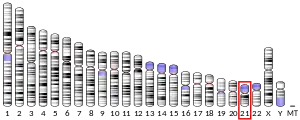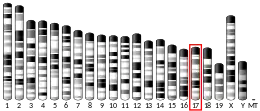WDR4
tRNA (guanine-N(7)-)-methyltransferase subunit WDR4 is an enzyme that in humans is encoded by the WDR4 gene.[5]
This gene encodes a member of the WD repeat protein family. WD repeats are minimally conserved regions of approximately 40 amino acids typically bracketed by gly-his and trp-asp (GH-WD), which may facilitate formation of heterotrimeric or multiprotein complexes. Members of this family are involved in a variety of cellular processes, including cell cycle progression, signal transduction, apoptosis, and gene regulation.
This gene is excluded as a candidate for a form of nonsyndromic deafness (DFNB10), but is still a candidate for other disorders mapped to 21q22.3 as well as for the development of Down syndrome phenotypes. Two transcript variants encoding the same protein have been found for this gene.[5]
References
- GRCh38: Ensembl release 89: ENSG00000160193 - Ensembl, May 2017
- GRCm38: Ensembl release 89: ENSMUSG00000024037 - Ensembl, May 2017
- "Human PubMed Reference:". National Center for Biotechnology Information, U.S. National Library of Medicine.
- "Mouse PubMed Reference:". National Center for Biotechnology Information, U.S. National Library of Medicine.
- "Entrez Gene: WDR4 WD repeat domain 4".
Further reading
- Michaud J, Kudoh J, Berry A, et al. (2001). "Isolation and characterization of a human chromosome 21q22.3 gene (WDR4) and its mouse homologue that code for a WD-repeat protein". Genomics. 68 (1): 71–9. doi:10.1006/geno.2000.6258. PMID 10950928.
- Alexandrov A, Martzen MR, Phizicky EM (2002). "Two proteins that form a complex are required for 7-methylguanosine modification of yeast tRNA". RNA. 8 (10): 1253–66. doi:10.1017/S1355838202024019. PMC 1370335. PMID 12403464.
- Strausberg RL, Feingold EA, Grouse LH, et al. (2003). "Generation and initial analysis of more than 15,000 full-length human and mouse cDNA sequences". Proc. Natl. Acad. Sci. U.S.A. 99 (26): 16899–903. doi:10.1073/pnas.242603899. PMC 139241. PMID 12477932.
- Ota T, Suzuki Y, Nishikawa T, et al. (2004). "Complete sequencing and characterization of 21,243 full-length human cDNAs". Nat. Genet. 36 (1): 40–5. doi:10.1038/ng1285. PMID 14702039.
- Gerhard DS, Wagner L, Feingold EA, et al. (2004). "The Status, Quality, and Expansion of the NIH Full-Length cDNA Project: The Mammalian Gene Collection (MGC)". Genome Res. 14 (10B): 2121–7. doi:10.1101/gr.2596504. PMC 528928. PMID 15489334.
- Cartlidge RA, Knebel A, Peggie M, et al. (2005). "The tRNA methylase METTL1 is phosphorylated and inactivated by PKB and RSK in vitro and in cells". EMBO J. 24 (9): 1696–705. doi:10.1038/sj.emboj.7600648. PMC 1142581. PMID 15861136.
- Rual JF, Venkatesan K, Hao T, et al. (2005). "Towards a proteome-scale map of the human protein-protein interaction network". Nature. 437 (7062): 1173–8. Bibcode:2005Natur.437.1173R. doi:10.1038/nature04209. PMID 16189514. S2CID 4427026.
- Hu YH, Warnatz HJ, Vanhecke D, et al. (2006). "Cell array-based intracellular localization screening reveals novel functional features of human chromosome 21 proteins". BMC Genomics. 7: 155. doi:10.1186/1471-2164-7-155. PMC 1526728. PMID 16780588.
- Olsen JV, Blagoev B, Gnad F, et al. (2006). "Global, in vivo, and site-specific phosphorylation dynamics in signaling networks". Cell. 127 (3): 635–48. doi:10.1016/j.cell.2006.09.026. PMID 17081983. S2CID 7827573.



